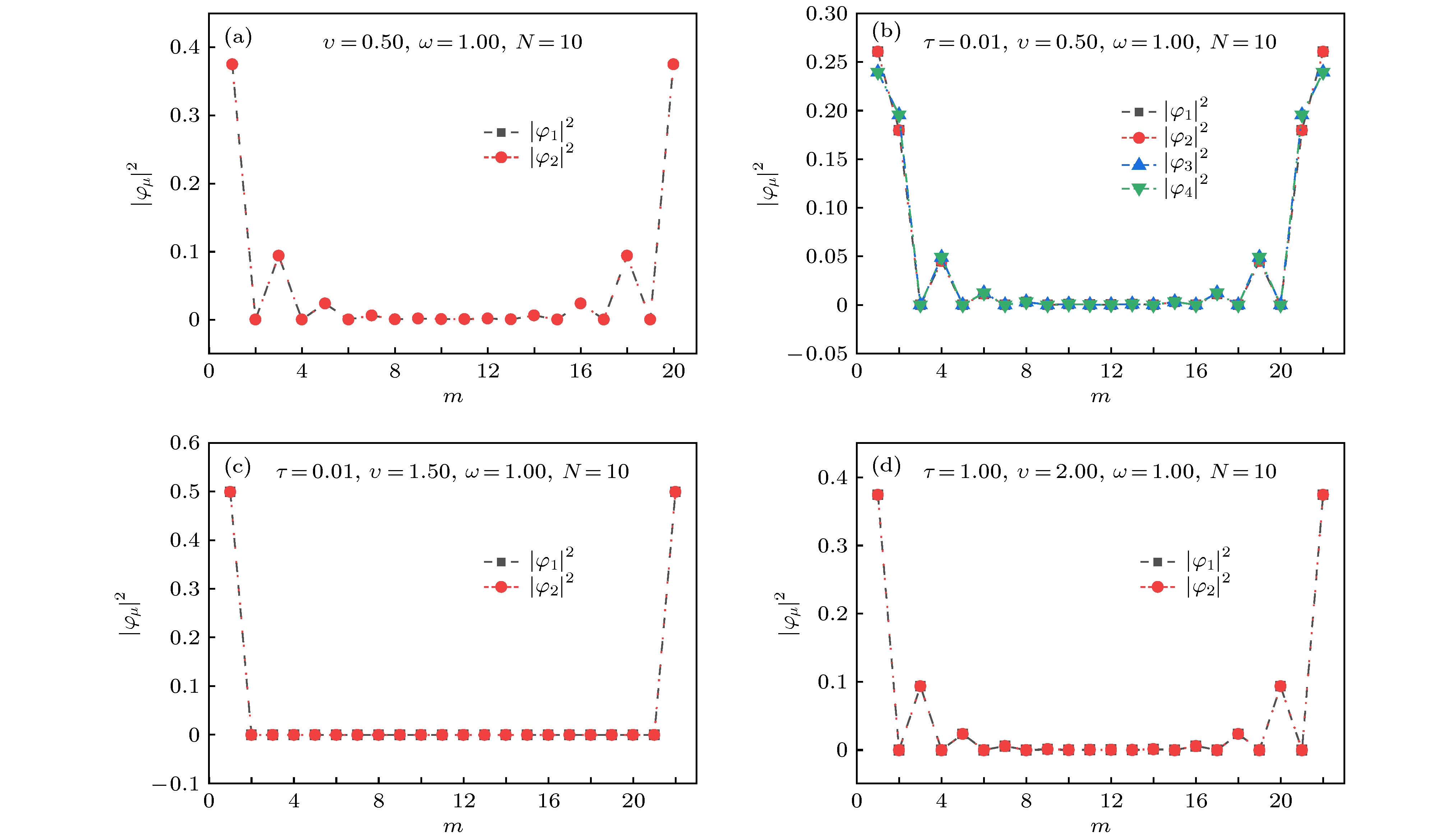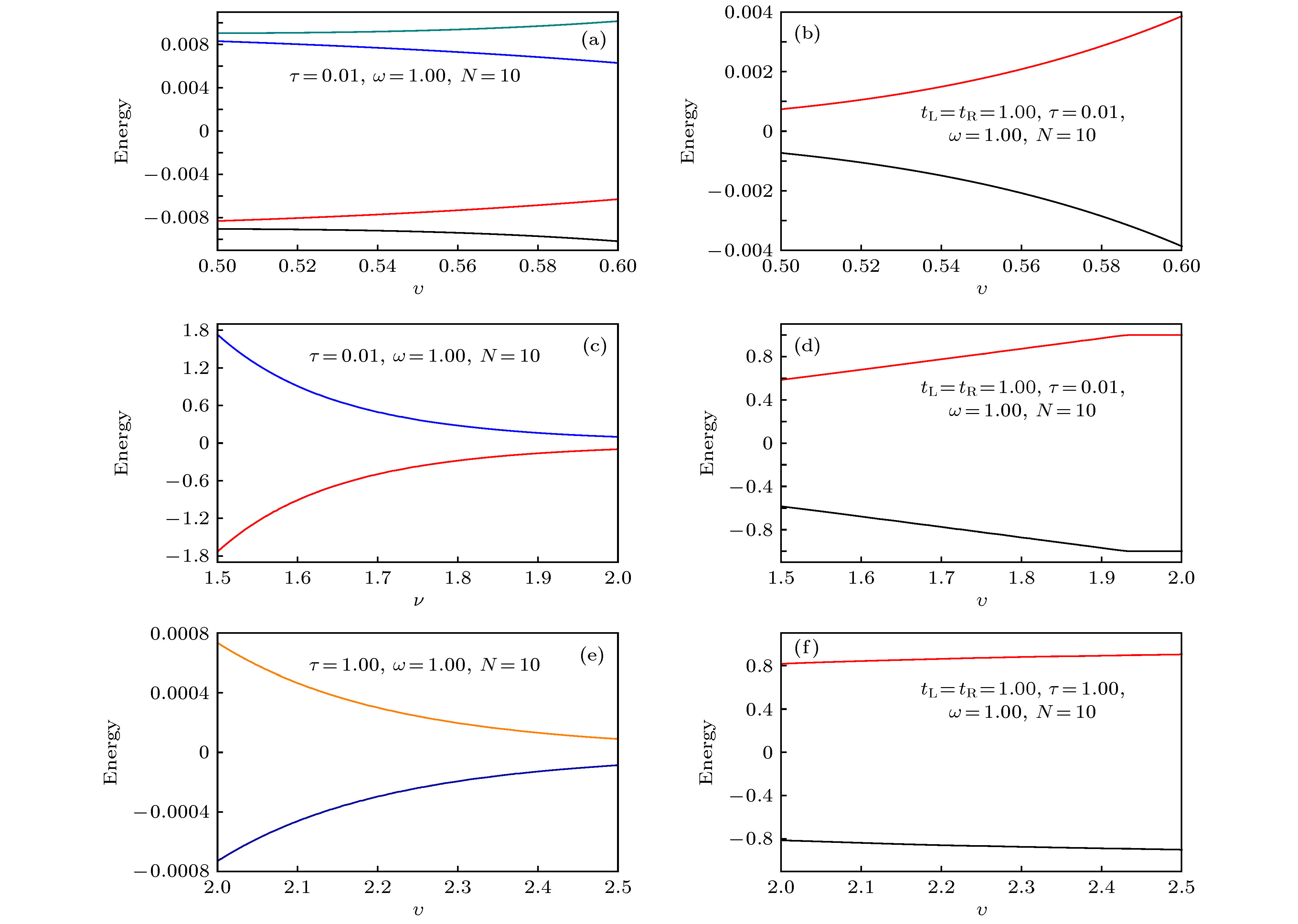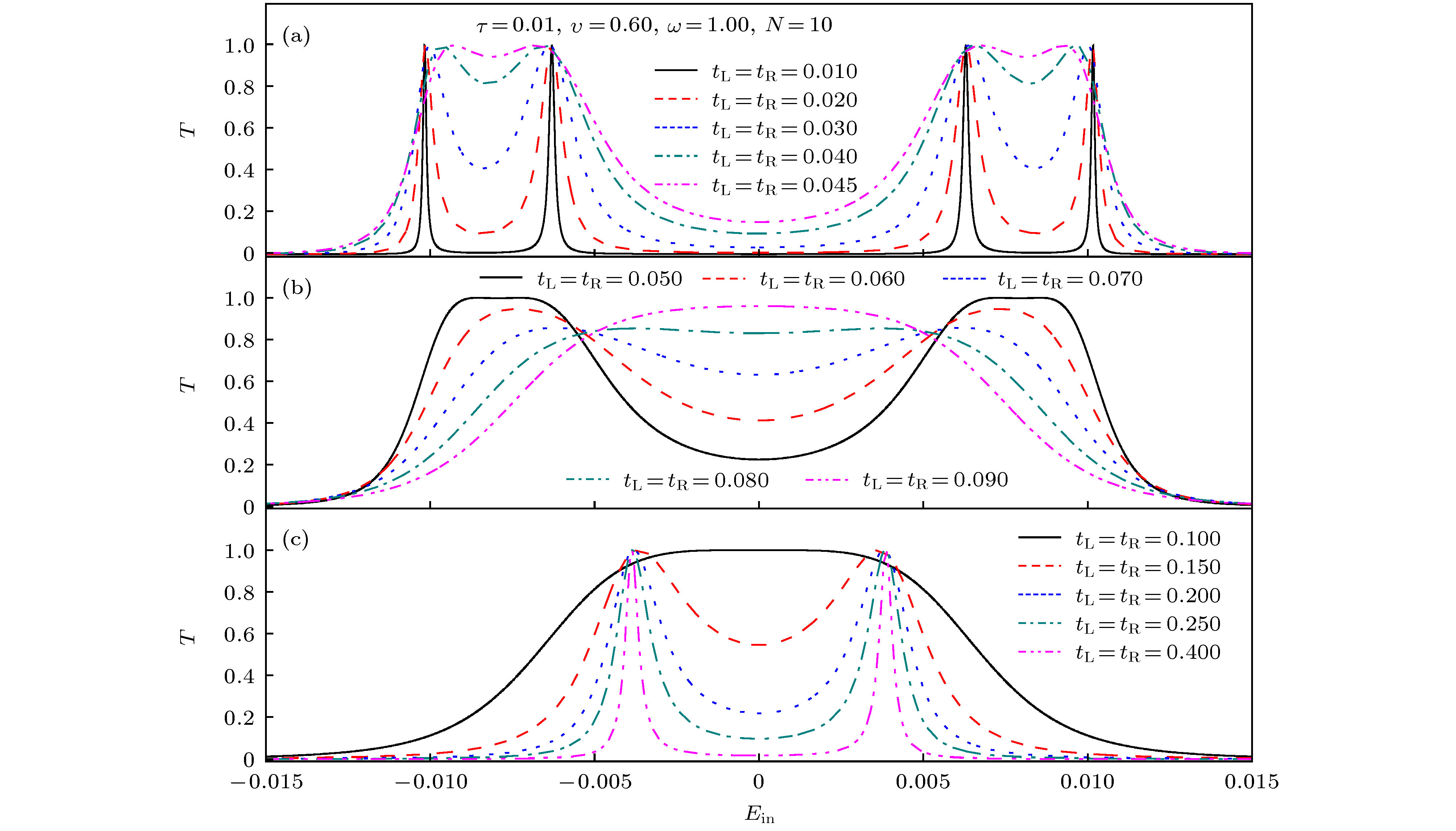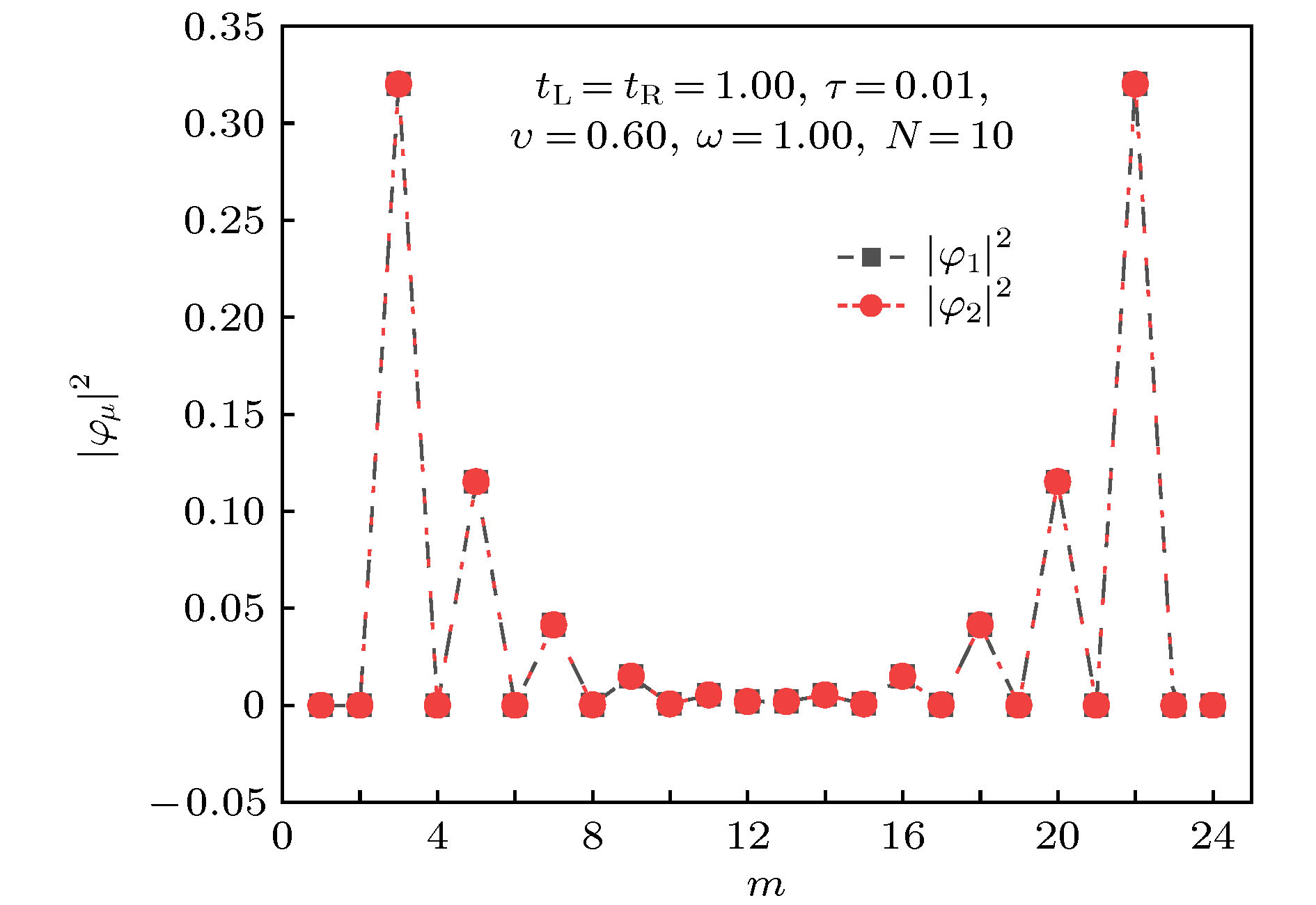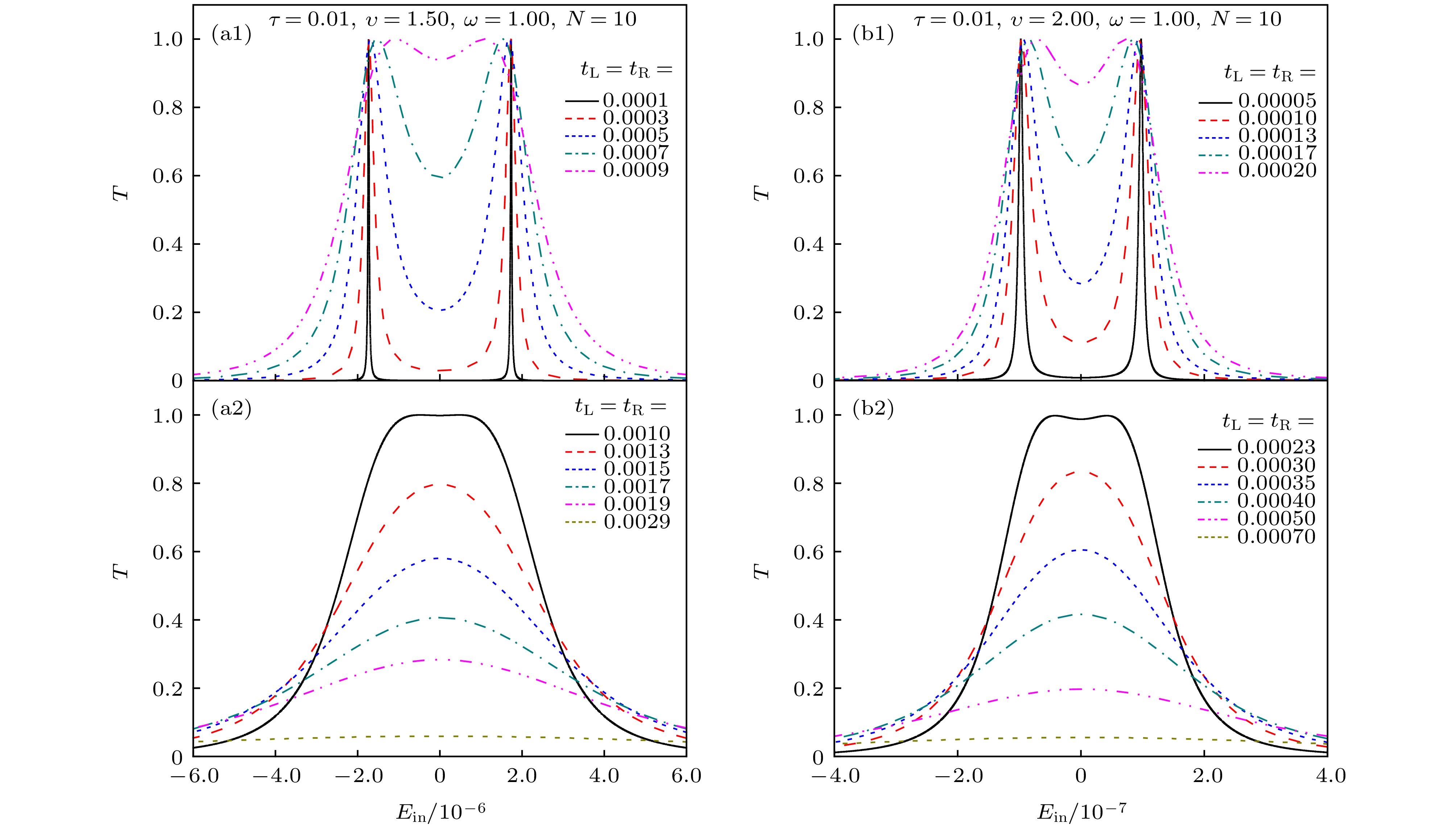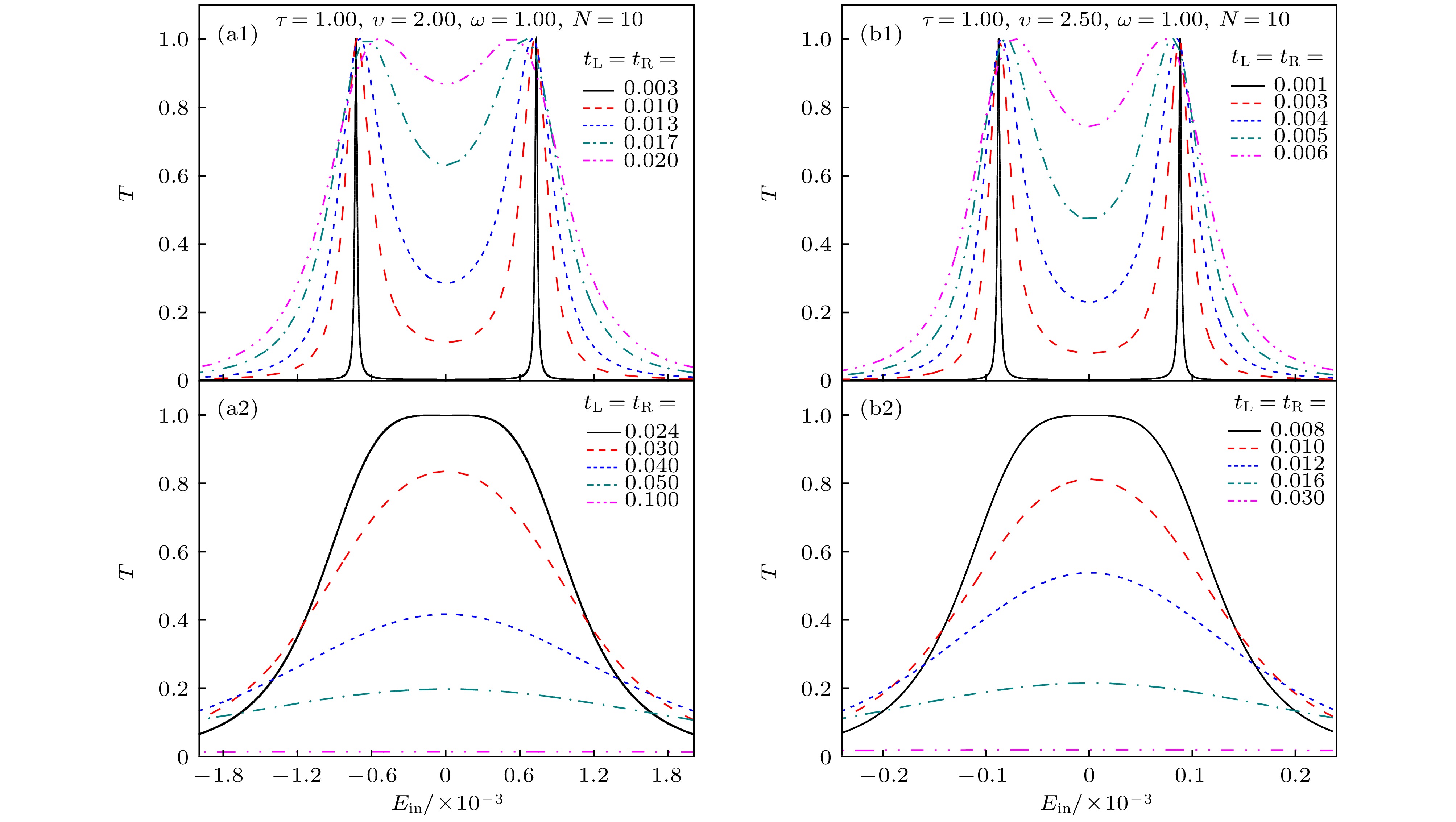-
The Su-Schrieffer-Heeger (SSH) is a typical one-dimensional system with topological edge states, which has been experimentally realized in the photon and cold atom systems.Therefore, how to confirm the existence of the edge states from theoretical and experimental has become one of the most important topics in condensed matter physics. In this paper, using the tight-binding approximation and transfer-matrix method, we have studied the transport signatures of electron through a quantum dot-SSH chain hybrid system. Here,the two quantum dots play a role in modulating the tunneling coupling strength between the SSH chain and the two electrodes.When the quantum dots are weakly coupled to the SSH chain, the quadruple-degenerate edge states of the quantum dot-SSH chain hybrid system correspond to that the SSH chain has two degenerate zero-energy edge states; whereas the twofold-degenerate ones correspond to that the SSH chain has no edge states. While the quantum dots are strongly coupled to the SSH chain, the edge states only exist when the intra-cell hopping amplitude is larger than the inter-cell hopping amplitude. In this situation, however, there is no edge states in the SSH chain. In particular, when the quantum dot-SSH chain hybrid system is strongly coupled to the two external electrodes, the number of transmission resonance peaks of the edge states of the quantum dot-SSH chain hybrid system will be reduced by 2. For example, in the case of the quadruple-degenerate edge states, the number of transmission resonance peaks will be two; whereas in the case of twofold-degenerate ones, that will disappear. Therefore, by modulating the tunneling coupling strength between the quantum dots and the SSH chain and that between the quantum dots and the two external electrodes, we can observe the variation of the number of transmission resonance peaks of edge states to detect whether the SSH chain is in the nontrivial topological state or not.
-
Keywords:
- edge states /
- Su-Schrieffer-Heeger chain /
- transmission probability
[1] Asbóth J K, Oroszlány L, Pályi A 2016 A Short Course on Topological Insulators (Budapest: Springer) pp: 1-99
[2] Jürß C, Bauer D 2019 Phys. Rev. B 99 195428
 Google Scholar
Google Scholar
[3] Wang Y, Lu Y H, Mei F, Gao J, Li Z M, Tang H, Zhu S L, Jia S, Jin X M 2019 Phys. Rev. Lett. 122 193903
 Google Scholar
Google Scholar
[4] Longhi S 2013 Opt. Lett. 38 003716
 Google Scholar
Google Scholar
[5] Atala M, Aidelsburger M, Barreiro J T, Abanin D, Kitagawa T, Demler E, Bloch I 2013 Nat. Phys. 9 795
 Google Scholar
Google Scholar
[6] Du L, Wu J H, Artoni M, La Rocca G C 2019 Phys. Rev. A 100 012112
 Google Scholar
Google Scholar
[7] Obana D, Liu F, Wakabayashi K 2019 Phys. Rev. B 100 075437
 Google Scholar
Google Scholar
[8] Ryu S, Hatsugai Y 2002 Phys. Rev. Lett. 89 077002
 Google Scholar
Google Scholar
[9] 卢曼昕, 邓文基 2019 物理学报 68 120301
 Google Scholar
Google Scholar
Lu M X, Deng W J 2019 Acta Phys. Sin. 68 120301
 Google Scholar
Google Scholar
[10] 许楠, 张岩 2019 物理学报 68 104206
 Google Scholar
Google Scholar
Xu N, Zhang Y 2019 Acta Phys. Sin. 68 104206
 Google Scholar
Google Scholar
[11] Li C, Lin S, Zhang G, Song Z 2017 Phys. Rev. B 96 125418
 Google Scholar
Google Scholar
[12] Padavić K, Hegde S S, DeGottardi W, Vishveshwara S 2018 Phys. Rev. B 98 024205
 Google Scholar
Google Scholar
[13] Marques A M, Dias R G 2017 Phys. Rev. B 95 115443
 Google Scholar
Google Scholar
[14] Li L, Xu Z, Chen S 2014 Phys. Rev. B 89 085111
 Google Scholar
Google Scholar
[15] Asbóth J K, Tarasinski B, Delplace P 2014 Phys. Rev. B 90 125143
 Google Scholar
Google Scholar
[16] Ozcakmakli Turker Z, Yuce C 2019 Phys. Rev. A 99 022127
 Google Scholar
Google Scholar
[17] Yuce C 2018 Phys. Rev. A 98 012111
 Google Scholar
Google Scholar
[18] Yuce C 2018 Phys. Rev. A 97 042118
 Google Scholar
Google Scholar
[19] Hafezi M 2014 Phys. Rev. Lett. 112 210405
 Google Scholar
Google Scholar
[20] Bardyn C E, Huber C D, Zilberberg O 2014 New J. Phys. 16 123013
 Google Scholar
Google Scholar
[21] Poshakinskiy A V, Poddubny A N, Hafezi M 2015 Phys. Rev. A 91 043830
 Google Scholar
Google Scholar
[22] Aidelsburger M, Lohse M, Schweizer C, Atala M, Barreiro J T, Nascimbene S, Cooper N R, Bloch I, Goldman N 2015 Nat. Phys. 11 162
 Google Scholar
Google Scholar
[23] Dong B, Lei X L 2018 Ann. Phys. 396 245
 Google Scholar
Google Scholar
[24] Böhling S, Engelhardt G, Platero G, Schaller G 2018 Phys. Rev. B 98 035132
 Google Scholar
Google Scholar
[25] Niklas M, Benito M, Kohler S, Platero G 2016 Nanotechnology 27 454002
 Google Scholar
Google Scholar
[26] Dutta P, Maiti S K 2015 Rev. Theor. Sci. 3 224
 Google Scholar
Google Scholar
-
图 1 量子点-SSH原子链系统的示意图. 其中, 空心圆为电极上的原子, 阴影圆表示量子点, 红色圆表示A原子, 蓝色圆表示B原子.
${t_0}$ 是电极上最近邻两个原子之间的跳跃振幅,${t_\eta }(\eta = {\rm{L, R}})$ 表示导线与量子点之间的隧穿耦合强度,$\tau $ 为量子点与SSH原子链之间的隧穿耦合强度,$\upsilon $ 为胞内的跳跃振幅,$\omega $ 为胞间的跳跃振幅, N为原胞数目Figure 1. Schematic of the considered quantum dot-SSH chain hybrid system. The hollow circles denote atoms on the leads, the shadow circles are the quantum dots, red circles are the A atoms, the blue circles represent the B atoms.
${t_0}$ is the hopping amplitude between the two nearest-neighbor atoms on the leads.${t_\eta }~(\eta = {\rm{L, R}})$ describes the strength of tunneling coupling between the lead-η and quantum dot-η,$\tau $ is the strength of tunneling coupling between quantum dot and SSH chain,$\upsilon $ and$\omega $ denote the intra-cell and inter-cell hopping amplitudes, respectively. N is the number of unit cells.图 2 (a) SSH原子链的能谱图; (b)和(c)量子点-SSH原子链系统的能谱图, 其中, (b)
$\tau = 0.01$ , (c)$\tau = 1.00$ . 胞间跳跃振幅$\omega = 1.00$ , 原胞数目$N = 10$ Figure 2. (a) Energy spectrum of the SSH chain; (b) and (c) Energy spectrum of the quantum dot-SSH chain hybrid system, where (b)
$\tau = 0.01$ and (c)$\tau = 1.00$ . Here,$\omega = 1.00$ and$N = 10$ .图 3 (a) SSH原子链的零能模波函数在每个格点位置上的几率分布, 其中,
$\upsilon = 0.50$ ; (b)−(d) 量子点-SSH原子链系统的零能模波函数在每个格点位置上的几率分布, 其中: (b)$\tau = 0.01$ ,$\upsilon = 0.50$ ; (c)$\tau = 0.01$ ,$\upsilon = 1.50$ ; (d)$\tau = 1.00$ $\upsilon = 2.00$ Figure 3. (a) The probability distributions of wave functions of the zero-energy modes at each sites in the SSH chain with
$\upsilon = 0.50$ ; (b)−(d) The probability distributions of wave functions of the zero-energy modes at each sites in the quantum dot-SSH chain hybrid system, where (b)$\tau = 0.01$ ,$\upsilon = 0.50$ , (c)$\tau = 0.01$ ,$\upsilon = 1.50$ , (d)$\tau = 1.00$ $\upsilon = 2.00$ .图 4 (a), (c)和(e)量子点-SSH原子链系统在零能级附近的能谱图; (b), (d)和(f)量子点-SSH原子链系统与左、右电极第–1个和第1个原子耦合的系统在零能级附近的能谱图, 其中,
${t_{\rm{L}}} = {t_{\rm{R}}} = 1.00$ Figure 4. (a), (c) and (e)Energy spectrum of the quantum dot-SSH chain hybrid system in the vicinity of the zero energy; (b), (d) and (f) Energy spectrum of the quantum dot-SSH chain hybrid system coupled to the first atom (–1) of the left lead and the first atom (1) of the right one in the vicinity of the zero energy at
${t_{\rm{L}}} = {t_{\rm{R}}} = 1.00$ .图 5 对于不同的隧穿耦合强度, 量子点-SSH原子链系统的电子透射率随入射电子能量的变化. 其中,
$\tau = 0.01$ ,$\upsilon = 0.60$ ,$\omega = 1.00$ ,$N = 10$ Figure 5. The transmission probability versus the energy of incident electron for different strengths of tunneling coupling at
$\tau = 0.01$ ,$\upsilon = 0.60$ ,$\omega = 1.00$ and$N = 10$ .图 6 量子点-SSH原子链系统与左、右电极第–1个和第1个原子耦合系统的零能模波函数在每个格点位置上的几率分布. 其他参数与图5相同.
Figure 6. The probability distributions of wave functions of the zero-energy modes at each sites in the quantum dot-SSH chain hybrid system coupled to the first atom (–1) of the left lead and the first atom (1) of the right one. The other parameters are the same as in Fig. 5.
图 7 对于不同的隧穿耦合强度, 量子点-SSH原子链系统的电子透射率随入射电子能量的变化. 其中,
$\tau = 0.01$ ,$\omega = 1.00$ ,$N = 10$ . (a1)和(a2)$\upsilon = 1.50$ ; (b1)和(b2)$\upsilon = 2.00$ Figure 7. The transmission probability versus the energy of incident electron for different strengths of tunneling coupling at
$\tau = 0.01$ ,$\omega = 1.00$ and$N = 10$ . (a1) and (a2)$\upsilon = 1.50$ ; (b1) and (b2)$\upsilon = 2.00$ .图 8 对于不同的隧穿耦合强度, 量子点-SSH原子链系统的电子透射率随入射电子能量的变化. 其中,
$\tau = 1.00$ ,$\omega = 1.00$ ,$N = 10$ . (a1)和(a2)$\upsilon = 2.00$ ; (b1)和(b2)$\upsilon = 2.50$ Figure 8. The transmission probability versus the energy of incident electron for different strengths of tunneling coupling at
$\tau = 1.00$ ,$\omega = 1.00$ and$N = 10$ . (a1) and (a2)$\upsilon = 2.00$ ; (b1) and (b2)$\upsilon = 2.50$ . -
[1] Asbóth J K, Oroszlány L, Pályi A 2016 A Short Course on Topological Insulators (Budapest: Springer) pp: 1-99
[2] Jürß C, Bauer D 2019 Phys. Rev. B 99 195428
 Google Scholar
Google Scholar
[3] Wang Y, Lu Y H, Mei F, Gao J, Li Z M, Tang H, Zhu S L, Jia S, Jin X M 2019 Phys. Rev. Lett. 122 193903
 Google Scholar
Google Scholar
[4] Longhi S 2013 Opt. Lett. 38 003716
 Google Scholar
Google Scholar
[5] Atala M, Aidelsburger M, Barreiro J T, Abanin D, Kitagawa T, Demler E, Bloch I 2013 Nat. Phys. 9 795
 Google Scholar
Google Scholar
[6] Du L, Wu J H, Artoni M, La Rocca G C 2019 Phys. Rev. A 100 012112
 Google Scholar
Google Scholar
[7] Obana D, Liu F, Wakabayashi K 2019 Phys. Rev. B 100 075437
 Google Scholar
Google Scholar
[8] Ryu S, Hatsugai Y 2002 Phys. Rev. Lett. 89 077002
 Google Scholar
Google Scholar
[9] 卢曼昕, 邓文基 2019 物理学报 68 120301
 Google Scholar
Google Scholar
Lu M X, Deng W J 2019 Acta Phys. Sin. 68 120301
 Google Scholar
Google Scholar
[10] 许楠, 张岩 2019 物理学报 68 104206
 Google Scholar
Google Scholar
Xu N, Zhang Y 2019 Acta Phys. Sin. 68 104206
 Google Scholar
Google Scholar
[11] Li C, Lin S, Zhang G, Song Z 2017 Phys. Rev. B 96 125418
 Google Scholar
Google Scholar
[12] Padavić K, Hegde S S, DeGottardi W, Vishveshwara S 2018 Phys. Rev. B 98 024205
 Google Scholar
Google Scholar
[13] Marques A M, Dias R G 2017 Phys. Rev. B 95 115443
 Google Scholar
Google Scholar
[14] Li L, Xu Z, Chen S 2014 Phys. Rev. B 89 085111
 Google Scholar
Google Scholar
[15] Asbóth J K, Tarasinski B, Delplace P 2014 Phys. Rev. B 90 125143
 Google Scholar
Google Scholar
[16] Ozcakmakli Turker Z, Yuce C 2019 Phys. Rev. A 99 022127
 Google Scholar
Google Scholar
[17] Yuce C 2018 Phys. Rev. A 98 012111
 Google Scholar
Google Scholar
[18] Yuce C 2018 Phys. Rev. A 97 042118
 Google Scholar
Google Scholar
[19] Hafezi M 2014 Phys. Rev. Lett. 112 210405
 Google Scholar
Google Scholar
[20] Bardyn C E, Huber C D, Zilberberg O 2014 New J. Phys. 16 123013
 Google Scholar
Google Scholar
[21] Poshakinskiy A V, Poddubny A N, Hafezi M 2015 Phys. Rev. A 91 043830
 Google Scholar
Google Scholar
[22] Aidelsburger M, Lohse M, Schweizer C, Atala M, Barreiro J T, Nascimbene S, Cooper N R, Bloch I, Goldman N 2015 Nat. Phys. 11 162
 Google Scholar
Google Scholar
[23] Dong B, Lei X L 2018 Ann. Phys. 396 245
 Google Scholar
Google Scholar
[24] Böhling S, Engelhardt G, Platero G, Schaller G 2018 Phys. Rev. B 98 035132
 Google Scholar
Google Scholar
[25] Niklas M, Benito M, Kohler S, Platero G 2016 Nanotechnology 27 454002
 Google Scholar
Google Scholar
[26] Dutta P, Maiti S K 2015 Rev. Theor. Sci. 3 224
 Google Scholar
Google Scholar
Catalog
Metrics
- Abstract views: 10284
- PDF Downloads: 272
- Cited By: 0

























 DownLoad:
DownLoad:









